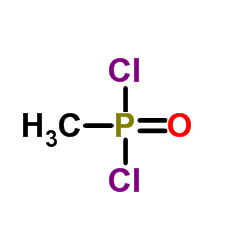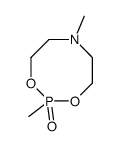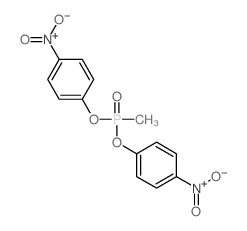Methylphosphonic dichloride

Methylphosphonic dichloride structure
|
Common Name | Methylphosphonic dichloride | ||
|---|---|---|---|---|
| CAS Number | 676-97-1 | Molecular Weight | 132.914 | |
| Density | 1.4±0.1 g/cm3 | Boiling Point | 163.0±0.0 °C at 760 mmHg | |
| Molecular Formula | CH3Cl2OP | Melting Point | 32-60ºC | |
| MSDS | Chinese USA | Flash Point | 44.1±18.7 °C | |
| Symbol |


GHS05, GHS06 |
Signal Word | Danger | |
| Name | Methylphosphonic Dichloride |
|---|---|
| Synonym | More Synonyms |
| Density | 1.4±0.1 g/cm3 |
|---|---|
| Boiling Point | 163.0±0.0 °C at 760 mmHg |
| Melting Point | 32-60ºC |
| Molecular Formula | CH3Cl2OP |
| Molecular Weight | 132.914 |
| Flash Point | 44.1±18.7 °C |
| Exact Mass | 131.929855 |
| PSA | 26.88000 |
| LogP | 0.25 |
| Vapour Pressure | 2.8±0.3 mmHg at 25°C |
| Index of Refraction | 1.420 |
| InChIKey | SCLFRABIDYGTAZ-UHFFFAOYSA-N |
| SMILES | CP(=O)(Cl)Cl |
| Stability | Stable, but may decompose in the presence of water or moisture. Incompatible with water, strong bases, strong oxidizing agents. |
| Water Solubility | Soluble in water. |
Synonym: Section 2 - COMPOSITION, INFORMATION ON INGREDIENTS
Risk Phrases: 23/24/25 34 Section 3 - HAZARDS IDENTIFICATION EMERGENCY OVERVIEW
Toxic by inhalation, in contact with skin and if swallowed. Causes burns.The toxicological properties of this material have not been fully investigated.Moisture sensitive. Potential Health Effects Eye: Causes eye burns. Skin: Causes skin burns. Toxic in contact with skin. Ingestion: Poison by ingestion. Causes gastrointestinal tract burns. The toxicological properties of this substance have not been fully investigated. Inhalation: May cause irritation of the respiratory tract with burning pain in the nose and throat, coughing, wheezing, shortness of breath and pulmonary edema. Causes chemical burns to the respiratory tract. Inhalation may be fatal as a result of spasm, inflammation, edema of the larynx and bronchi, chemical pneumonitis and pulmonary edema. Toxic if inhaled. Chronic: Not available. Section 4 - FIRST AID MEASURES Eyes: Immediately flush eyes with plenty of water for at least 15 minutes, occasionally lifting the upper and lower eyelids. Get medical aid immediately. Skin: Get medical aid immediately. Immediately flush skin with plenty of water for at least 15 minutes while removing contaminated clothing and shoes. Ingestion: Get medical aid immediately. Wash mouth out with water. Inhalation: Get medical aid immediately. Remove from exposure and move to fresh air immediately. If not breathing, give artificial respiration. If breathing is difficult, give oxygen. Notes to Physician: Section 5 - FIRE FIGHTING MEASURES General Information: As in any fire, wear a self-contained breathing apparatus in pressure-demand, MSHA/NIOSH (approved or equivalent), and full protective gear. Not flammable, but reacts with most metals to form flammable hydrogen gas. Extinguishing Media: Use foam, dry chemical, or carbon dioxide. DO NOT USE WATER! Section 6 - ACCIDENTAL RELEASE MEASURES General Information: Use proper personal protective equipment as indicated in Section 8. Spills/Leaks: Vacuum or sweep up material and place into a suitable disposal container. Section 7 - HANDLING and STORAGE Handling: Do not breathe dust, vapor, mist, or gas. Do not get in eyes, on skin, or on clothing. Handle under an inert atmosphere. Use only in a chemical fume hood. Storage: Store in a cool, dry place. Store in a tightly closed container. Keep under a nitrogen blanket. Corrosives area. Section 8 - EXPOSURE CONTROLS, PERSONAL PROTECTION Engineering Controls: Use adequate ventilation to keep airborne concentrations low. Exposure Limits CAS# 676-97-1: Personal Protective Equipment Eyes: Wear appropriate protective eyeglasses or chemical safety goggles as described by OSHA's eye and face protection regulations in 29 CFR 1910.133 or European Standard EN166. Skin: Wear appropriate protective gloves to prevent skin exposure. Clothing: Wear appropriate protective clothing to prevent skin exposure. Respirators: Follow the OSHA respirator regulations found in 29 CFR 1910.134 or European Standard EN 149. Use a NIOSH/MSHA or European Standard EN 149 approved respirator if exposure limits are exceeded or if irritation or other symptoms are experienced. Section 9 - PHYSICAL AND CHEMICAL PROPERTIES Physical State: Solid Color: colorless Odor: Not available. pH: Not available. Vapor Pressure: 760 mm Hg @ 163 Viscosity: Not available. Boiling Point: 163 deg C @ 760.00mm Hg Freezing/Melting Point: 35 - 37 deg C Autoignition Temperature: Not available. Flash Point: > 110 deg C (> 230.00 deg F) Explosion Limits, lower: Not available. Explosion Limits, upper: Not available. Decomposition Temperature: Solubility in water: Specific Gravity/Density: 1.4680g/cm3 Molecular Formula: CH3Cl2OP Molecular Weight: 132.91 Section 10 - STABILITY AND REACTIVITY Chemical Stability: Not available. Conditions to Avoid: Incompatible materials, exposure to moist air or water. Incompatibilities with Other Materials: Strong bases - strong oxidizing agents. Hazardous Decomposition Products: Hydrogen chloride, phosphine, carbon monoxide, oxides of phosphorus, carbon dioxide. Hazardous Polymerization: Has not been reported Section 11 - TOXICOLOGICAL INFORMATION RTECS#: CAS# 676-97-1: TA1840000 LD50/LC50: CAS# 676-97-1: Inhalation, rat: LC50 = 26 ppm/4H. Carcinogenicity: Methylphosphonic dichloride - Not listed by ACGIH, IARC, or NTP. Other: See actual entry in RTECS for complete information. Section 12 - ECOLOGICAL INFORMATION Section 13 - DISPOSAL CONSIDERATIONS Dispose of in a manner consistent with federal, state, and local regulations. Section 14 - TRANSPORT INFORMATION IATA Shipping Name: TOXIC SOLID, CORROSIVE, ORGANIC, N.O.S.* Hazard Class: 6.1 (8) UN Number: 2928 Packing Group: I IMO Shipping Name: TOXIC SOLID, CORROSIVE, ORGANIC, N.O.S. Hazard Class: 6.1 (8) UN Number: 2928 Packing Group: I RID/ADR Shipping Name: TOXIC SOLID, CORROSIVE, ORGANIC, N.O.S. Hazard Class: 6.1 UN Number: 2928 Packing group: I Section 15 - REGULATORY INFORMATION European/International Regulations European Labeling in Accordance with EC Directives Hazard Symbols: T Risk Phrases: R 23/24/25 Toxic by inhalation, in contact with skin and if swallowed. R 34 Causes burns. Safety Phrases: S 22 Do not breathe dust. S 26 In case of contact with eyes, rinse immediately with plenty of water and seek medical advice. S 36/37/39 Wear suitable protective clothing, gloves and eye/face protection. S 45 In case of accident or if you feel unwell, seek medical advice immediately (show the label where possible). WGK (Water Danger/Protection) CAS# 676-97-1: No information available. Canada CAS# 676-97-1 is listed on Canada's NDSL List. CAS# 676-97-1 is not listed on Canada's Ingredient Disclosure List. US FEDERAL TSCA CAS# 676-97-1 is listed on the TSCA inventory. SECTION 16 - ADDITIONAL INFORMATION N/A |
CHEMICAL IDENTIFICATION
HEALTH HAZARD DATAACUTE TOXICITY DATA
|
| Symbol |


GHS05, GHS06 |
|---|---|
| Signal Word | Danger |
| Hazard Statements | H314-H330 |
| Supplemental HS | Contact with water liberates toxic gas., Reacts violently with water. |
| Precautionary Statements | P260-P280-P284-P305 + P351 + P338-P310 |
| Personal Protective Equipment | Eyeshields;Faceshields;Gloves;type P2 (EN 143) respirator cartridges |
| Hazard Codes | T+ |
| Risk Phrases | R14;R26;R34 |
| Safety Phrases | S26-S28-S36/37/39-S45 |
| RIDADR | UN 3390 6 |
| WGK Germany | 3 |
| RTECS | TA1840000 |
| Packaging Group | I |
| Hazard Class | 6.1 |
|
Kinetics and mechanism of beta-lactamase inhibition by phosphonamidates: the quest for a proton.
Biochemistry 32 , 10763, (1993) Four phosphonamidates were synthesized as potential beta-lactamase inhibitors. Three were methanephosphonamidates [CH3PO2-NHR/Ar, where R/Ar = 4-methoxybenzyl (3a), phenyl (3b), and m-nitrophenyl (3c)... |
|
|
Helv. Chim. Acta 75 , 2520, (1992)
|
|
|
Synth. Commun. 23 , 2273, (1993)
|
| EINECS 211-634-4 |
| Methanephosphonyl chloride |
| MFCD00002071 |
| Methylphosphonyl dichloride |
| Methylphosphonicdichlorid |
| Phosphonic dichloride, P-methyl- |
| dichlorophosphorylmethane |
| Methyl phosphonyl dichloride |
![1-[chloro(methyl)phosphoryl]oxyoctane structure](https://image.chemsrc.com/caspic/407/51419-58-0.png) CAS#:51419-58-0
CAS#:51419-58-0 CAS#:52202-92-3
CAS#:52202-92-3![1-chloro-4-[(4-chlorophenoxy)-methylphosphoryl]oxybenzene structure](https://image.chemsrc.com/caspic/032/6395-59-1.png) CAS#:6395-59-1
CAS#:6395-59-1 CAS#:6395-57-9
CAS#:6395-57-9![1-[chloro(methyl)phosphoryl]oxy-4-nitrobenzene structure](https://image.chemsrc.com/caspic/120/36459-53-7.png) CAS#:36459-53-7
CAS#:36459-53-7 CAS#:7647-01-0
CAS#:7647-01-0 CAS#:4206-94-4
CAS#:4206-94-4